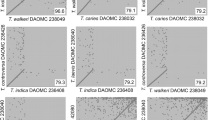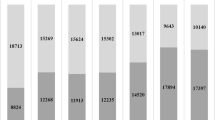Abstract
Tuta absoluta is one of the most devastating pests of fresh market and processing tomatoes. Native to South America, its detection was confined to that continent until 2006 when it was identified in Spain. It has now spread to almost every continent, threatening countries whose economies rely heavily on tomatoes. This insect causes damage to all developmental stages of its host plant, leading to crop losses as high as 80–100%. Although T. absoluta has yet to be found in the USA and China, which makes up a large portion of the tomato production in the world, computer models project a high likelihood of invasion. To halt the continued spread of T. absoluta and limit economic loss associated with tomato supply chain, it is necessary to develop accurate and efficient methods to identify T. absoluta and strengthen surveillance programs. Current identification of T. absoluta relies on examination of morphology and assessment of host plant damage, which are difficult to differentiate from that of native tomato pests. To address this need, we sequenced the genomes of T. absoluta and two closely related Gelechiidae, Keiferia lycopersicella and Phthorimaea operculella, and developed a bioinformatic pipeline to design a panel of 21-SNP markers for species identification. The accuracy of the SNP panel was validated in a multiplex format using the iPLEX chemistry of Agena MassARRAY system. Finally, the new T. absoluta genomic resources we generated can be leveraged to study T. absoluta biology and develop species-specific management strategies.



Similar content being viewed by others
Data availability
All genome sequencing data generated from this study have been deposited to BioProject accession number PRJNA512383 in the NCBI BioProject database (https://www.ncbi.nlm.nih.gov/bioproject/). The Whole Genome Shotgun project of T. absoluta has been deposited at DDBJ/ENA/GenBank under the accession SNMR00000000. The version described in this paper is version SNMR01000000.
References
Ajamma YU, Mararo E, Omondi D et al (2016) Rapid and high throughput molecular identification of diverse mosquito species by high resolution melting analysis. F1000Research 5:1949
Arnó J, Oveja MF, Gabarra R (2018) Selection of flowering plants to enhance the biological control of Tuta absoluta using parasitoids. Biol Control 122:41–50
Bahamondes LA, Mallea AL (1969) Biología en Mendoza de Scrobipalpula absoluta (Meyrick) Polvony (Lepidoptera: Gelechiidae), especie nueva para la República Argentina. Revista de la Facultad de Ciencias Agrarias 15:96–104
Bawin T, Dujeu D, DeBaker L et al (2015) Could alternative solanaceous hosts act as refuges for the tomato leafminer, Tuta absoluta? Arthropod Plant Interact 9:425–435
Bettaibi A, Mezghani-Khemakhem M, Bouktila D et al (2012) Genetic variability of the tomato leaf miner (Tuta absoluta Meyrick; Lepidoptera: Gelechiidae) in Tunisia, inferred from RAPD-PCR. Chilean J Agric Res 72:212–216
Biondi A, Narciso R, Guedes C et al (2018) Ecology, worldwide spread, and management of the invasive South American tomato pinworm, Tuta absoluta: past, present, and future. Ann Rev Entomol 63:239–258
Bolger AM, Lohse M, Usadel B (2014) Trimmomatic: a flexible trimmer for illumina sequence data. Bioinformatics 30:2114–2120
CABI (Centre for Agriculture and Bioscience International) (2016) Tuta absoluta. CABI website https://www.cabi.org/isc/datasheet/49260. Accessed 20 Oct 2018
Camargo RA, Herai RH, Santos LN et al (2015) De novo transcriptome assembly and analysis to identify potential gene targets for RNAi-mediated control of the tomato leafminer (Tuta absoluta). BMC Genom 16:635
Camargo RA, Barbosa GO, Possignolo IP et al (2016) RNA interference as a gene silencing tool to control Tuta absoluta in tomato (Solanum lycopersicum). Peer J 4:e2673
Campos MR, Biondi A, Adiga A (2017) From the Western Palaearctic region to beyond: Tuta absoluta ten years after invading Europe. J Pest Sci 90:787–796
Cifuentes D, Chynoweth R, Bielza P (2011) Genetic study of Mediterranean and South American populations of tomato leafminer Tuta absoluta (Povolny, 1994) (Lepidoptera: Gelechiidae) using ribosomal and mitochondrial markers. Pest Manag Sci 67:1155–1162
Darling AE, Mau B, Perna NT (2010) progressiveMauve: multiple genome alignment with gene gain, loss and rearrangement. PLoS ONE 5:e11147
Desneux N, Wajberg E, Wyckhuys K et al (2010) Biological invasion of European tomato crops by Tuta absoluta: ecology, geographic expansion and prospects for biological control. J Pest Sci 83:197–215
Desneux N, Luna M, Guillemaud T et al (2011) The invasive South America tomato pinworm, Tuta absoluta, continues to spread in Afro-Eurasia and beyond: the new threat to tomato world production. J Pest Sci 84:403–408
Dhami MK, Kumarasinghe L (2014) A HRM real-time PCR assay for rapid and specific identification of the emerging pest Spotted-Wing Drosophila (Drosophila suzukii). PLoS ONE 9:e98934
Dhami MK, Dsouza M, Waite DW et al (2016) Real-time PCR assay for the identification of the brown marmorated stink bug (Halyomorpha halys). Front Mol Biosci 3:5
Dobin A, Davis CA, Schlesinger F et al (2013) STAR: ultrafast universal RNA-seq aligner. Bioinformatics 29:15–21
Đurić Z, Delić D, Hrnčić S et al (2014) Distribution and molecular identification of Tuta absoluta (Meyrick, 1917) (Lepidoptera, Gelechiidae) populations in Bosnia and Herzegovina and Montenegro. Pol J Entomol 83:121–129
EPPO Global Database (2019) Tecia solanivora (TECASO). https://gd.eppo.int/taxon/TECASO/distribution. Accessed 15 Feb 2019
FAOSTAT (Food Agric. Org. U. N.) (2017) FAOSTAT statistics database. Rome, Italy. http://www.fao.org/faostat. Accessed 20 Oct 2018
Gabriel S, Ziaugra L, Tabbaa D (2009) SNP genotyping using the Sequenom MassARRAY iPLEX platform. Curr Protoc Hum Genet 2:1–18
Gaskill DAR (2013) Tuta absoluta and the tomato commodity survey. Florida CAPS annual workshop and meeting presentation. https://www.freshfromflorida.com/Divisions-Offices/Plant-Industry/Bureaus-and-Services/CAPS/CAPS-Presentations-and-Outreach. Accessed 15 Feb 2019
Guillemaud T, Blin A, Le Goff I et al (2015) The tomato borer, Tuta absoluta, invading the Mediterranean Basin, originates from a single introduction from Central Chile. Sci Rep 5:8371
Han P, Zhang YN, Lu ZZ et al (2018) Are we ready for the invasion of Tuta absoluta? Unanswered key questions for elaborating an integrated pest management package. Entomol Gen 38:113–125
Han P, Bayram Y, Shaltiel-Harpez L et al (2019) Tuta absoluta continues to disperse in Asia: damage, ongoing management and future challenges. J Pest Sci. https://doi.org/10.1007/s10340-018-1062-1
Katoh K, Standley D (2013) MAFFT multiple sequence alignment software version 7: improvements in performance and usability. Mol Bio Evol 30:772–780
Kopylova E, Noé L, Touzet H (2012) SortMeRNA: fast and accurate filtering of ribosomal RNAs in meta-transcriptomic data. Bioinformatics 28:3211–3217
Lee S, Brambila J (2012) A new species of the genus Sinoe (Lepidoptera: Gelechiidae: Litini) from Florida. Fla Entomol 95:873–876
Lee Y, Marsden CD, Norris LC et al (2013) Spatiotemporal dynamics of gene flow and hybrid fitness between the M and S forms of the malaria mosquito, Anopheles gambiae. Proc Natl Acad Sci USA 110:19854–19859
Lee Y, Marsden CD, Nieman CC et al (2014) A new multiplex SNP genotyping assay for detecting hybridization and introgression between the M and S molecular forms of Anopheles gambiae. Mol Ecol Resour 14:297–305
Lee Y, Weakley AM, Nieman CC et al (2015) A multi-detection assay for malaria transmitting mosquitoes. J Vis Exp 96:e52385
Li H, Durbin R (2009) Fast and accurate short read alignment with Burrows–Wheeler transform. Bioinformatics 25:1754–1760
Linck H, Kruger E, Reineke A (2017) A multiplex TaqMan aPCR assay for sensitive and rapid detection of phytoplasmas infecting Rubus species. PLoS ONE 12:e0177808
Luo R, Liu B, Xie Y et al (2012) SOAPdenovo2: an empirically improved memory-efficient short-read de novo assembler. Gigascience 1:18
Mansour R, Brevault T, Chailleux A et al (2018) Occurrence, biology, natural enemies and management of Tuta absoluta in Africa. Entomol Gen 38:83–112
Marçais G, Kingsford C (2011) A fast, lock-free approach for efficient parallel counting of occurrences of k-mers. Bioinformatics 27:764–770
Michalak PS (2011) New pest guidelines for tomato leaf miner (Tuta absoluta). http://www.aphis.usda.gov/import_export/plants/manuals/emergency/index.shtml. Accessed 20 Oct 2018
Mohamed ESI, Mahmoud MEE, Elhaj MAM (2015) Host plants record for tomato leaf miner Tuta absoluta (Meyrick) in Sudan. Bull OEPP/EPPO 45:108–111
Mutamiswa R, Machekano H, Nyamukondiwa C (2017) First report of tomato leaf miner, Tuta absoluta (Meyrick) (Lepidoptera: Gelechiidae), in Botswana. Agric Food Secur 6:49
Negi S, Sharma PL, Sharma KC (2018) Effect of host plants on developmental and population parameters of invasive leafminer, Tuta absoluta (Meyrick) (Lepidoptera: Gelechiidae). Phytoparasitica 46:213–221
Nieman CC, Yamasaki Y, Collier TC et al (2015) A DNA extraction protocol for improved DNA yield from individual mosquitoes. F1000Research 4:1314
Pereyra P, Sanchez N (2006) Effect of two solanaceous host plants on development and population parameters of the tomato leaf miner, Tuta absoluta (Meyrick) (Lepidoptera: Gelechiidae). Neotrop Entomol 35:671–676
Povolny D (1975) On three neotropical species of Gnorimoschemini (Lepidoptera, Gelechiidae) mining Solanaceae. Acta Univ Agric 23:379–393
Povolny D (1994) Gnorimoschemini of southern South America VI: identification keys, checklist of Neotropical taxa and general considerations (Insecta, Lepidoptera, Gelechiidae). Steenstrupia 20:1–42
Simao FA, Waterhouse RM, Ioannidis P et al (2015) BUSCO: assessing genome assembly and annotation completeness with single-copy orthologs. Bioinformatics 31:3210–3212
Sint D, Sporleder M, Wallinger C et al (2016) A two-dimensional pooling approach towards efficient detection of parasitoid and pathogen DNA at low infestation rates. Methods Ecol Evol 7:1548–1557
Stamatakis A (2014) RAxML version 8: a tool for phylogenetic analysis and post-analysis of large phylogenies. Bioinformatics 30:1312–1313
Teeter KC, Thibodeau LM, Gompert Z et al (2010) The variable genomic architecture of isolation between hybridizing species of house mice. Evolution 64:472–485
Tonnang HEZ, Mohamed SF, Khamis F (2015) Identification and risk assessment for worldwide invasion and spread of Tuta absoluta with a focus on sub-Saharan Africa: implications for phytosanitary measures and management. PLoS ONE 10:e0135283
USDA (United States Department of Agriculture) (2011) New pest response guidelines: tomato leafminer (Tuta absoluta). USDA Animal and Plant Health and Inspection Service website. https://www.aphis.usda.gov/import_export/plants/manuals/emergency/downloads/Tuta-absoluta.pdf. Accessed 20 Oct 2018
Vurture GW, Sedlazeck FJ, Nattestad M et al (2017) GenomeScope: fast reference-free genome profiling from short reads. Bioinformatics 33:2202–2220
Yamasaki YK, Nieman CC, Chang AN (2016) Improved tools for genomic DNA library construction of small insects. F1000Research 5:211
Zhang Z, Schwartz S, Wagner L et al (2000) A greedy algorithm for aligning DNA sequences. J Comput Biol 7:203–214
Zhang T, Wang YJ, Guo W (2016) DNA barcoding, species–species PCR and real-time PCR techniques for the identification of six Tribolium pests of stored products. Sci Rep 6:28494
Acknowledgements
We would like to thank Dr. Yannery Gómez Bonilla (Investigator, Entomologia, INTA, Costa Rica) for the samples from Costa Rica, Dr. Phil Stansly (Professor, University of Florida, USA) for the K. lycopersicella samples, and David Haviland (Entomology and IPM Farm Advisor, University of California Cooperative Extension, Bakersfield, CA, USA) for the P. operculella samples.
Funding
This project was supported by the Specialty Crop Block Program at the USA Department of Agriculture (USDA) through Grant 14-SCBGP-CA-006 to KG, FGZ, and JCC and USDA NIFA CA-D-ENM-2150-H awarded to JCC. Its contents are solely the responsibility of the authors and do not necessarily represent the official views of the USDA. JA and NA are funded by CERCA Programme (Generalitat de Catalunya).
Author information
Authors and Affiliations
Corresponding author
Ethics declarations
Conflict of interest
All authors declare that they have no conflict of interest.
Ethical approval
This article does not contain any studies with human participants or animals performed by any of the authors.
Additional information
Communicated by A. Biondi.
Publisher's Note
Springer Nature remains neutral with regard to jurisdictional claims in published maps and institutional affiliations.
Special Issue on Advances in the Management of Tuta absoluta.
Electronic supplementary material
Below is the link to the electronic supplementary material.
Rights and permissions
About this article
Cite this article
Tabuloc, C.A., Lewald, K.M., Conner, W.R. et al. Sequencing of Tuta absoluta genome to develop SNP genotyping assays for species identification. J Pest Sci 92, 1397–1407 (2019). https://doi.org/10.1007/s10340-019-01116-6
Received:
Revised:
Accepted:
Published:
Issue Date:
DOI: https://doi.org/10.1007/s10340-019-01116-6




